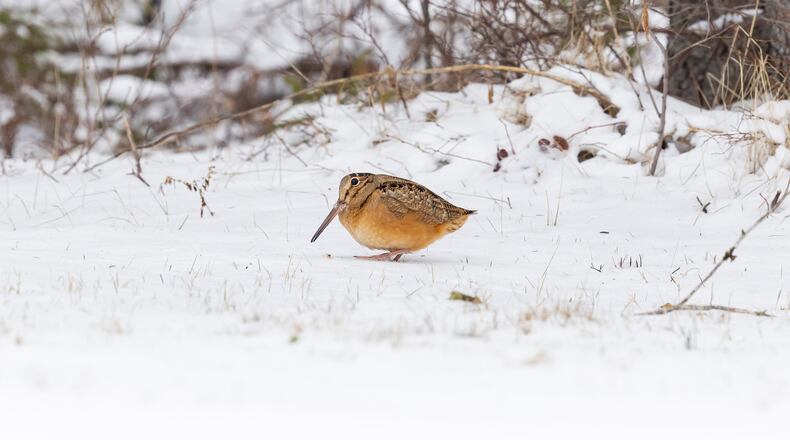It wasn’t a pheasant. It kind of looked like a snipe (the real kind). It was still years before the National Harvest Information Program had started, so we hadn’t declared we were after any migratory birds when we bought our license, or were asked if we’d be hunting woodcock.
While it hadn’t done any of the swervy acrobatic things that the woodcock I had read about were known for, and that made them difficult targets, we decided that that’s what it was.
A quick scan of the regulations kept handy in a pocket of an oversized hunting jacket (no cell phones then) revealed that they were indeed in season. Marching forward another 20 yards, and a second timberdoodle whirred upward and followed the same unobstructed straightway path for an easy shot.
And I missed with not a feather touched.
Following the trends
Nationwide, like a lot of birds, woodcock have been in decline for several decades. It started in the late ’60s early ’70s as the successional habitat of small and abandoned farms grew into mature stands. The tiling and draining of wetlands certainly haven’t help their cause either.
But throughout Southwest Ohio, woodcock, when they’re here, might be the most reliable and consistent of upland birds. They’re not at historic highs but seem to have stabilized. When they’re here is the catch.
While there are some local resident birds, far more migrate through from points north to more southern locations where their prehensile beak won’t be blocked by frozen ground. The season in Ohio started on Oct. 11, but in many years, the migration of birds through doesn’t begin until much nearer the closing date of the season, Nov. 24 this year. It all kind of depends on the weather north of us pushing them south as much as the weather here.
Finding the flights
I recall one fall season with my first German Shorthaired Pointer, Eva. We got out quite a bit that year and at one stretch were averaging close to five finds an hour. About half of our time was spent on publicly accessible ground. Maybe not great by Northern Michigan standards, but enough to keep it interesting locally.
In fact, she pointed the first bird she found. We were both new to the game, and I was too busy making my way through the underbrush to see that she was on point and put two and two together. The bird ultimately flushed.
And to keep the trend, no shot fired. We looked at each other and moved on.
The next year we found similar numbers in the same spots. That could make a person think that they had it all figured out; look for places with potentially black dirt and no bigger than wrist-sized trees that look miserable to walk through, and we found birds. The following fall it was like they never existed. Same time, same place, just no birds.
That’s kind of the magic of “the woodcock flights” as they’re called. Here today in bunches, maybe. Gone with the next northerly push of wind.
Moving advantages
One advantage that migratory birds, including woodcock, have compared to non-migratory birds is the HIP program. HIP is a nationwide program that was started in 1992 and fully implemented in 1999. Participation in the program is required for those hunting migratory birds.
It’s a self-reporting survey that documents intent for the upcoming year and activity and success from the previous year. Combine that with ongoing banding and radio-tracking efforts, spring singing ground counts, and information is collected on a number of fronts. The result is that wildlife biologists across the state, nation, and Northern Hemisphere have multiple data sources to pull from to make informed decisions.
Secondly, while migration has it’s own threats, the fact that the birds are accustomed to moving and finding habitat along the way could work in their favor.
Radio tracking migrating woodcock reveals they take anything but a linear route, but ultimately find their destination. Compare that to coveys of bobwhite quail for instance.
Homebodies by nature, quail aren’t inclined to venture hundreds of miles to find suitable habitat. Woodcock often return on their migrations to locations they know, just like I stop at the same familiar Speedway gas station on routine trips.
They are accustomed to covering ground, but first choice is a place they know. Their needs are pretty simple. With some cover overhead during the day, some penetrable soil below they’re feet, they’re set.
If you want to help upland creatures
Just all wildlife, survival depends on habitat. The best thing you can do to help their cause — whether it’s woodcock or warblers or bluebirds — is buy a hunting license. Second, join a conservation organization such as the Ruffed Grouse Society / American Woodcock Society. Lastly, if you’re able to help create or set aside habitat, do so.
Devin Meister is a local outdoors and wildlife enthusiast and has a blog called “Average Guy Outdoors.” He is an Ohio University graduate. Reach him at meister.devin@gmail.com.
MORE ONLINE
Notes on Woodcock Migration: youtube.com/watch?v=ivrPYA-CgBI&t=715s
Ruffed Grouse Society/American Woodcock Society: ruffedgrousesociety.org/
Migration map: ruffedgrouse.maps.arcgis.com/apps/webappviewer/index.html?id=130717a05023440a93138a696ad05b31
About the Author


